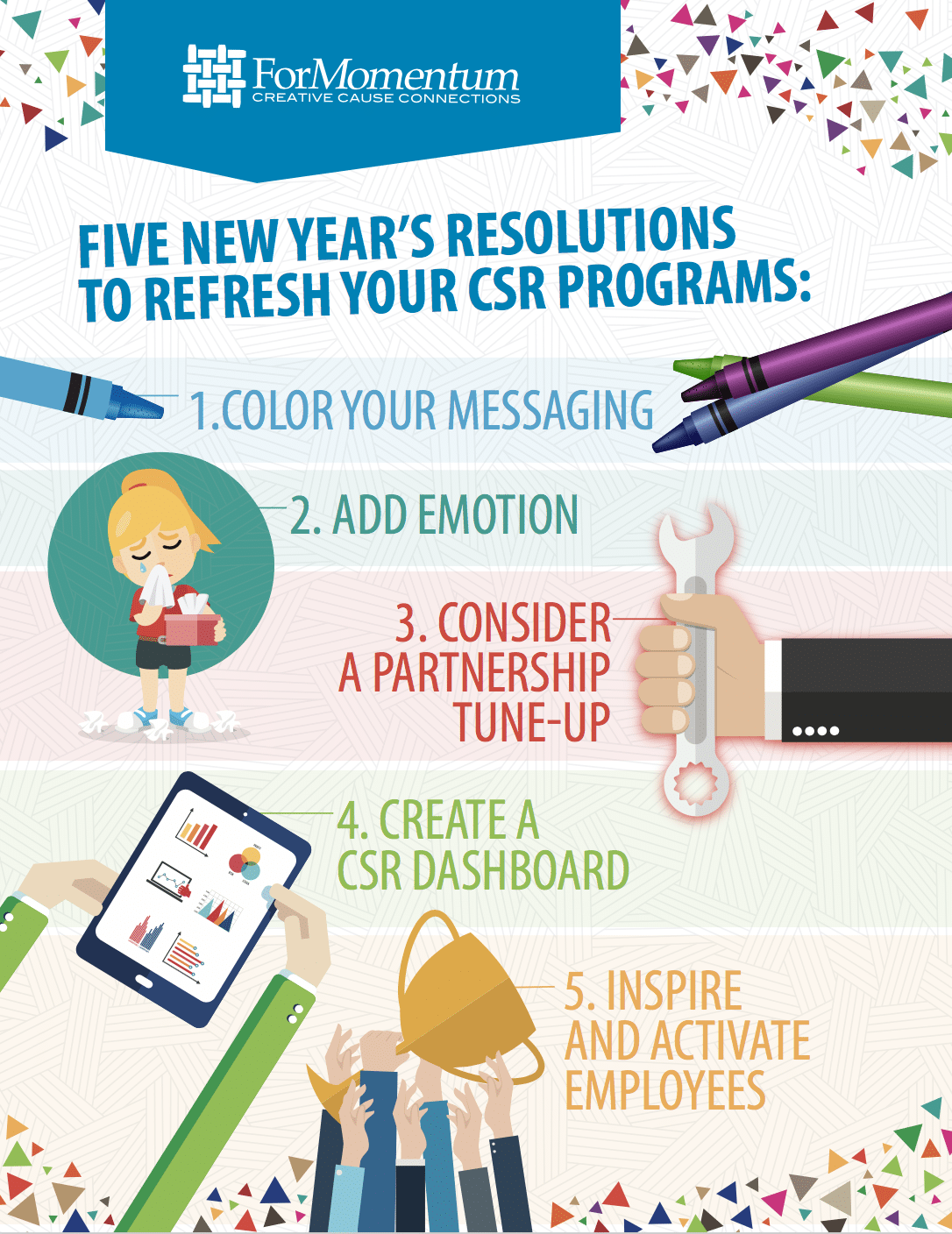By: Rich Maiore, Vice President, ForMomentum
With 2018 only a few weeks away, refining your strategy for your corporate philanthropy program is on your to-do list. As we go into the new year and are focused on improving our personal health and wellness, similar check-ups ring true for your corporate philanthropy program. It needs an annual health check-up to determine how to best maximize your resources and optimize your partnerships. Over the years of implementing several of these CSR check-ups for companies, I’ve found there are five resolutions CSR professionals can review to determine the health of their CSR programs and refresh them where necessary:
Resolution 1: Add Some Color to Stand Out

If you haven’t noticed, cause messages have flooded the marketplace. By our estimations, more than 25 cause and CSR news announcements arrive each day! The need to be memorable and have a point of view when it comes to CSR is more important than ever. Bland, tired messages will drown in a sea of sameness. Think of messages as colors. Too many companies stick to the primary colors when describing their philanthropy efforts and drafting their calls to action to employees and consumers. It’s time to break out the Crayola box of 64 crayons. Find some magenta, burnt sienna or periwinkle. Be a bit bolder, edgier and emotive with your messages. Coloring outside the lines often meets with greater reception and stickiness for your messages.
Resolution 2: Add Emotion by Cultivating Compelling Content

Storytelling is a big marketing buzzword. It’s an effective tool in a growing content marketing culture and certainly applies to philanthropy, an industry rich in compelling and emotional stories. To tell an effective story means having a strategy that covers sharing the right content via the right channel at the right time to the right audience. For companies, compelling storytelling is an efficient (time and resource-wise) and valuable way to reinforce your point of view and create an emotional connection.
Where can you source this great material? Start with your nonprofit partners. They are typically sitting on a treasure trove of raw content from videos, photographs, testimonials, research and infographics. All the things you need to tell a compelling, credible and memorable story. The key is to develop a low-maintenance process to collect the content, polish it up and promote it.
Resolution 3: Conduct a partnership tune-up

You invest a lot of time and effort to identify and align with nonprofit organizations that best match your brand and charitable mission. According to our 2015 Corporate Partner Research, brand alignment is the single most important factor for companies when selecting a nonprofit partner. After all that work, however, we find many times that companies do not fully optimize the partner’s organizational assets. Things like content, donor profiles and measurement tools can work harder for you within the existing agreement and budget.
To begin, work with your partner to develop a list of possible ways they can provide incremental value. To spur your thinking, we’re talking about things like: partner events, surveys, content, introduction to other corporate partners, and additional exposure opportunities to promote to your employees and customers. The list goes on and on. Challenge your partners to bring new ideas to the relationship.
Resolution 4: Develop a CSR Dashboard

Not only is the philanthropic landscape crowded, but it also has become more cynical. Research shows consumers are more skeptical of corporate philanthropic claims. They have a “prove it to me” mentality as if shouting in their best Cuba Gooding impersonation, “Show me the impact!”
Starting a discussion on what and how you will measure the impact and effectiveness of your efforts elicit groans because it’s hard to define and collect measurements. I get it. Don’t despair. Increasingly, companies are eschewing the time-consuming practice of creating annual CSR reports which rarely get read from cover to cover by employees or consumers.
There are a range of innovative yet low-cost ways to demonstrate the impact of your efforts in a clear and concise manner. This can look like impact calculators, hot maps, donation equivalences, quarterly infographics, digital report cards or video storytelling. Things your stakeholders—employees, leadership, community partners and ultimately consumers—will actually pay attention to, share and talk about. And isn’t that the point?
Remember: success doesn’t necessarily require more dollars, more partners or more elements. Some fine-tuning will go a long way to achieving a more compelling and impactful corporate philanthropy program.
Resolution 5: Inspire and Activate Employees

Employees are receiving much more attention these days as companies catch on to the idea that robust corporate philanthropy programs are effective and measurable tools that help recruit and retain employees. This is especially true for discerning Millennials who expect and want to work for companies with a defined CSR program. Today’s employees expect more. More information. More volunteer opportunities. More recognition. Moreover, your employee engagement programs need to be easy to find and to do. So keep it simple. Really simple.
Track an employee’s corporate philanthropy experience from beginning to end. This is an exercise we do with corporate clients that works well. Follow one employee’s process from start to finish. How and where do they learn about engagement opportunities—online, from their managers, in the breakroom? How can they get involved, track their time, share their experiences, be recognized and stewarded? We then determine at each step how the process can be simpler, easier and better coordinated.
We created the simple checklist below to print off or save, just click here to download the infographic.


Leave a Reply